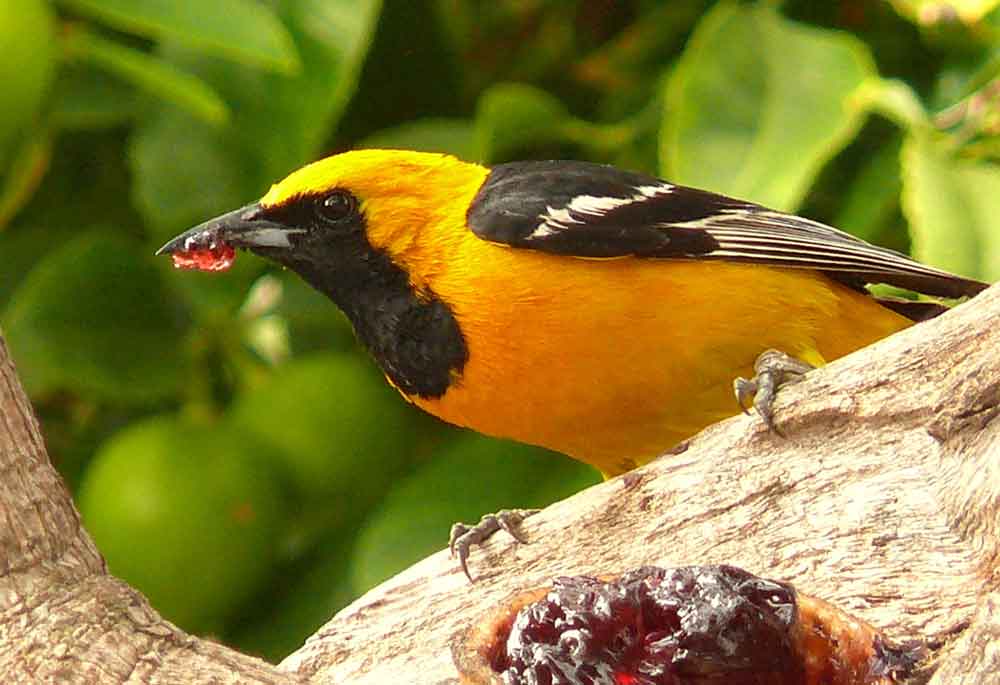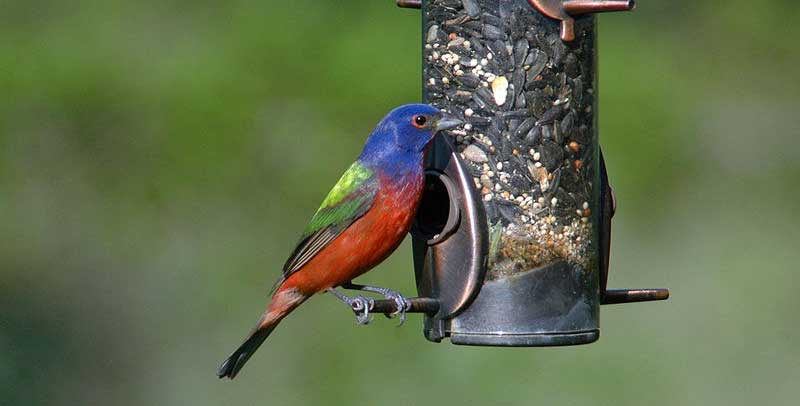
Peanuts. Suet. Nectar. Jelly.
If you’re new to feeding wild birds, the vast amounts of food available makes picking the type you want to offer birds overwhelming. You may not be sure what species certain foods attract or the types of food your current feeder can handle.
To help make things easier, we’ve created this guide that lays out all the different kinds of wild bird foods, what types of birds they typically attract and ideal feeders to serve them.
Types of Bird Seed
Seeds are the most common form of bird food. Here’s a breakdown of the different types of birdseed.
Sunflower Seeds
Sunflower seeds are by far the most popular type of birdseed, mainly because they attract the widest variety of species and offer great nutritional value. There are two types of sunflower seeds: black oil and striped.

Of the two, black oil sunflower seeds are more widely used because they have thinner shells, which allows nearly any seed-eating bird to crack them. Along with the ease of opening, the kernels have a high fat content to help birds survive the harsh winter months.
Striped sunflower seeds, on the other hand, are much more difficult for smaller birds to crack open. The reason you’d want to use striped sunflower seeds is if your feeder is getting raided by those pesky little brown birds, like House Sparrows, or blackbirds, like Common Grackles, because they wouldn’t be able to open them.
The next question is whether to feed your birds whole seeds or cracked. Sunflower hearts and chips tend to spoil more quickly, but whole sunflower seeds will leave more of a mess as birds crack them.
Sunflower seeds are best offered on feeders like platform feeders, hoppers, tube feeders and window feeders.
This type of seed attracts around 40 species, including cardinals, chickadees, jays, Evening Grosbeaks, Mourning Doves, nuthatches, House and Purple finches and many more.
Safflower Seeds
Safflower seeds are often used as an alternative to sunflower seeds because they are nutritionally similar in many ways and squirrels are said to dislike them. Safflower seeds are white and a little smaller than sunflower seeds but have a similar shape. This type of seed is not common, which is why you typically won’t find much in stores.
Many types of birds enjoy them, including cardinals, chickadees, doves, sparrows and even some grosbeaks. Another reason why these are popular is that more invasive species like House Sparrows and European Starlings don’t have a taste for safflower seeds.
These are best suited for tray and hopper feeders because typical visitors to those feeders enjoy safflower seeds the most.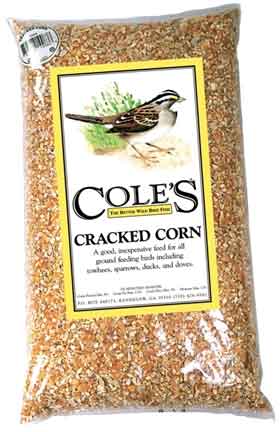
Cracked Corn
Yes, corn (technically the corn kernel) is another seed you can offer birds. Cracked corn is cracked into smaller bits and typically intended for livestock. You can usually find them in small stores or online and they are sometimes mixed in with other food because they are high in oil and starch.
Corn tends to spoil quickly, so it’s something you never want to leave out for long periods on rainy or humid days.
Many larger species like cardinals, turkeys, quails, grosbeaks, crows, jays and ducks eat corn. Since these are larger birds, offer corn in tray feeders on the ground.
Note: Never offer microwave popcorn or popped corn to birds.
White Proso Millet
Millet is a small, inexpensive grass seed that comes in different varieties. The best type of millet to offer is white proso millet because it’s nutritionally the best and attracts a wide range of species. White millet is a popular seed among ground-feeding birds like doves, cardinals, towhees and quails. However, you should be cautious of blackbirds and invasive sparrows because these species also love white millet.
White proso millet is great for platform feeders lower to the ground. You can even scatter some directly on the ground.
Peanuts

Peanuts are in the legume or bean family, but the delicious legume in the pod is technically a seed, so we’re including it in this section.
There was a news story not long ago in which an environmental health specialist said birds absolutely do not eat peanuts in a legal battle against a couple who was feeding birds. Needless to say, that’s 100% false.
Peanuts are highly nutritious for birds and are loved by a variety of species. We’ve written more extensively about peanuts in our Guide to Feeding Birds with Peanuts, but the types of birds that will eat them include jays, cardinals, chickadees, nuthatches, woodpeckers, crackles, towhees, doves and juncos. The list goes on.
You can offer them shelled or unshelled or raw or roasted. That’s more a matter of preference, but make sure you never give salted peanuts.
Scattering peanuts on the ground is the easiest way to offer them, but you can also put them on a platform feeder.
Milo
Milo is an inexpensive grain that comes in red and white varieties, but not many species eat milo.
According to the Cornell Lab of Ornithology, milo is preferred among Western ground-feeding birds like Stellar’s Jays, Curve-billed Thrashers and Gambel’s Quails. You can scatter milo on the ground or offer it in low tray feeders.
Nyjer
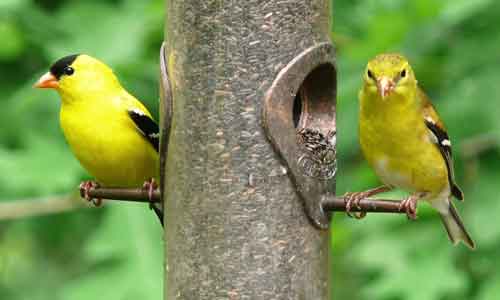
Nyjer is a small black seed that’s known by many names such as niger, blackseed and others. Nyjer, which is now a trademarked name by the Wild Bird Feeding Industry, is often referred to as thistle, despite the fact that it’s not related to thistle seed.
The reality of Nyjer is that it’s not actually a seed but a fruit called an achene. Still, it’s very frequently categorized as a seed.
Nyjer is a favorite among smaller birds like finches, juncos and siskins. This is best offered in tube feeders, but you can also find specially made Nyjer feeders.
Red Millet, Golden Millet, Flax and Filler Seeds
Then, of course, there’s a variety of seeds you’ll find in bags of mixed birdseed. Seeds like red millet and golden millet offer no real nutritional value and are often eschewed by birds. These are known as filler seeds because they’re meant to fill up bags of seed.
Mixed Bird Seeds
Generally, bargain bags of mixed bird seeds are not recommended because they’re usually filled with the filler seeds mentioned above. Most birds will not eat these filler seeds, so they’re a waste. However, there are quality blends, but you have to make sure they contain white millet instead of red and golden millet.
The types of bird a mix will attract depends on what’s in the bag and the common birds in your area.
Suet
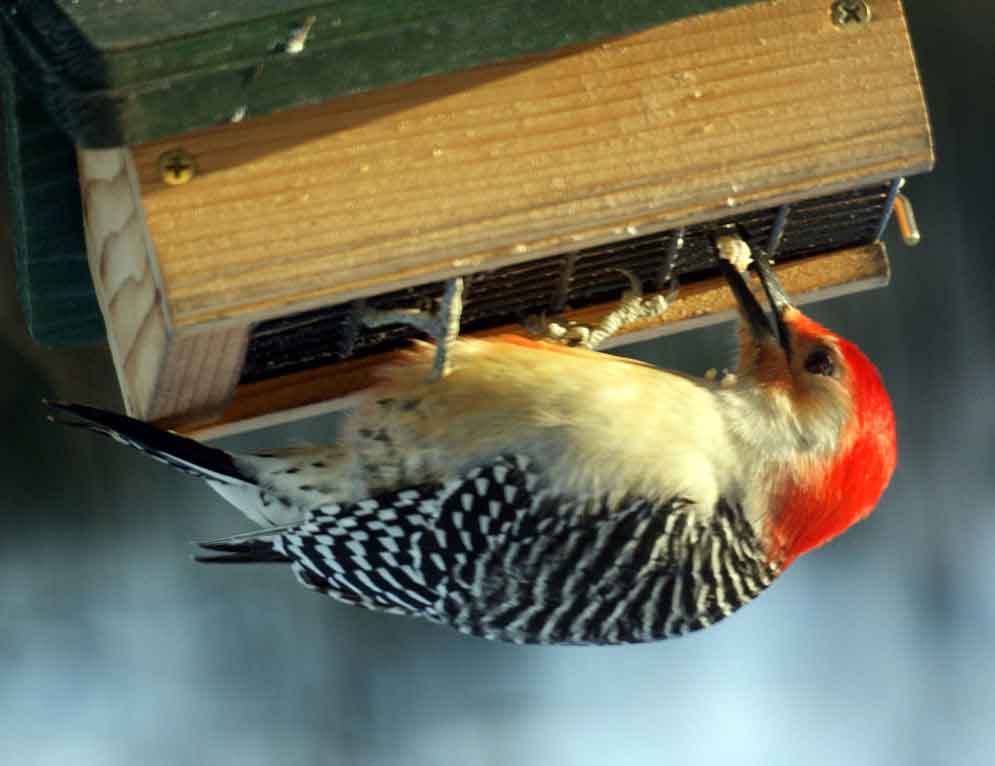
One of the most popular alternatives to birdseed is suet. The technical definition of suet is the hard fat around loins and kidneys, but suet is more commonly known as beef fat. Animal fat is a great treat for birds because it’s easily digested and provides birds with a lot of energy. This is one of the many reasons why suet is ideal to offer in the winter.
You have a few options for how to get suet. It’s not too difficult to make homemade suet at your house with a few ingredients that typically include lard, cornmeal, peanut butter and other items like nuts, seeds and dried fruits.
We reached out to some of our fans and customers on our Facebook page, picked their brains for suet recipes, and wrote up a post called 6 Simple Homemade Bird Suet Recipes for you to enjoy. Alternatively, you can buy pre-made suet cakes like those from Pine Tree Farms or Birds Choice.
Suet is best served in suet feeders that include squirrel-resistant cage suet feeders and upside down suet feeders.
A wide range of species enjoy eating suet, such as woodpeckers, nuthatches, chickadees, jays and some kinglets, titmice and wrens. You can find more information on suet in our more extensive blog post about suet.
Mealworms
We’re finally moving on to something alive (well, some of the time). Mealworms are inch-long larvae of an insect called a darkling beetle. Mealworms make fantastic food for birds because they’re high in protein, calcium and vitamins.
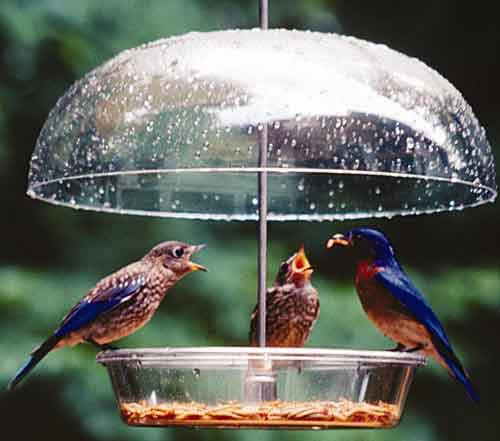
Mealworms can be fed to birds alive or dried. As with most wild animals, birds prefer when they’re alive and the movement of the mealworms attracts them, but it’s equally fine to serve them dried.
You can buy dried mealworms in large tubs of about 10,000. Alternatively, you can buy live ones or even raise your own. We won’t go into detail here about raising mealworms, but you can find more info at the helpful bluebird site Sialis.
Several types of bird feeders exist that focus on serving mealworms. There are single dishes that confine live or dried mealworms and there are feeders with options for different foods, including jelly, fruit and mealworms like the Birds Choice Supper Dome Feeder.
The main reason people bother with mealworms, regardless of how squeamish or grossed out they might be, is the simple fact that mealworms attract an array of species that won’t normally visit feeders. Just a small sample of the birds that enjoy mealworms are chickadees, wrens, woodpeckers, bluebirds and more.
Nectar
True nectar is the sugar-rich liquid made by flowers to attract pollinators like insects and birds. You can buy pre-made nectar to put in your feeders or powdered nectar that you just add water to.
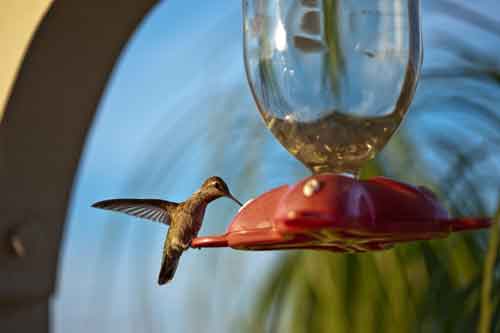
If you prefer the homemade method, a simple nectar recipe is four parts water to one part sugar, which closely matches the sugar content found in natural nectar.
The bird most commonly associated with nectar is the hummingbird, but a number of species also indulge in nectar. One family of birds that enjoys nectar is the oriole, but you’ll also spot certain woodpeckers, like the Ladder-backed Woodpecker, drinking nectar from hummingbird feeders. Outside of North America, sunbirds and honeyeaters will also drink nectar.
By far the most common method of serving nectar is through hummingbird feeders, which come in many varieties. However, some oriole feeders have slots for nectar and others are nectar-only feeders targeted at orioles.
Fruits
In North America, fruits aren’t commonly put out at bird feeders, even though a variety of birds love eating fruit. However, since it’s not as common here, it may be harder to get birds to come eat fruit from a feeder.
Fresh fruits like apples, berries, grapes, melons and oranges attract the widest array of species. Be sure to cut them into manageable sizes.
The main challenge of offering fresh fruit is that it doesn’t stay fresh for long, so you have to make sure to clean and replace it frequently.
How you offer up fruit will depend on the type of fruit and the type of bird you’re targeting. For example, you should use an oriole feeder if you’re putting out orange slices for orioles.
You can also put some food out on tray feeders. Fruit attracts bluebirds, mockingbirds, jays, waxwings, robins, thrushes, tanagers and many more.
Jelly
Jelly is similar to fruit in that it attracts some of the same species. There are differences, however. For one, jelly has a higher amount of sugar, which probably isn’t the healthiest for adult birds, but high sugar content does help birds manage colder weather.
When you put jelly out, make sure it’s only a small quantity because it can go bad and, worse, get extremely sticky.
Many fruit-eating birds will eat jelly. Some mealworm feeders double as jelly feeders and many oriole feeders have slots for jelly along with spots for nectar and orange halves.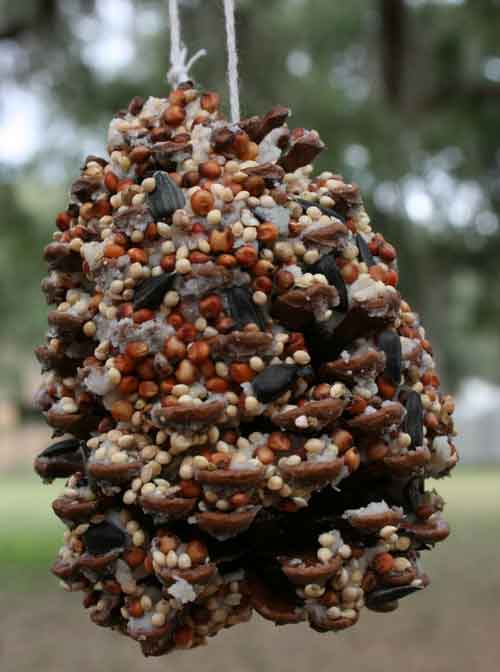
Peanut Butter
A favorite pastime for kids is creating a bird feeder using a pinecone smeared with peanut butter and rolled in birdseed. But is peanut butter good for birds? Yes, it is.
Peanut butter that’s safe for humans is also safe for birds and quite nutritious. You can also pick up peanut butter that’s specially made for wildlife.
Peanut butter attracts many of the same birds as regular peanuts like woodpeckers, nuthatches, sparrows, finches and more. A pinecone is a quick and easy way to offer up peanut butter to hungry birds, but there are also peanut butter bird feeders made by companies like Coveside Conservation Products.
Note: There’s a common belief that peanut butter is harder for birds to eat and may even get stuck in their mouths, resulting in suffocation. However, it’s just a misconception and peanut butter is perfectly safe for birds.
Leftover Scraps
Like a dog nipping at your foot under the table waiting for scraps, birds are also known to eat leftovers you put out for them. While some people put out old bread or leftover rice, the nutritional value offered by scraps usually isn’t enough to warrant the risk of potentially causing sickness in birds from old or unhealthy food.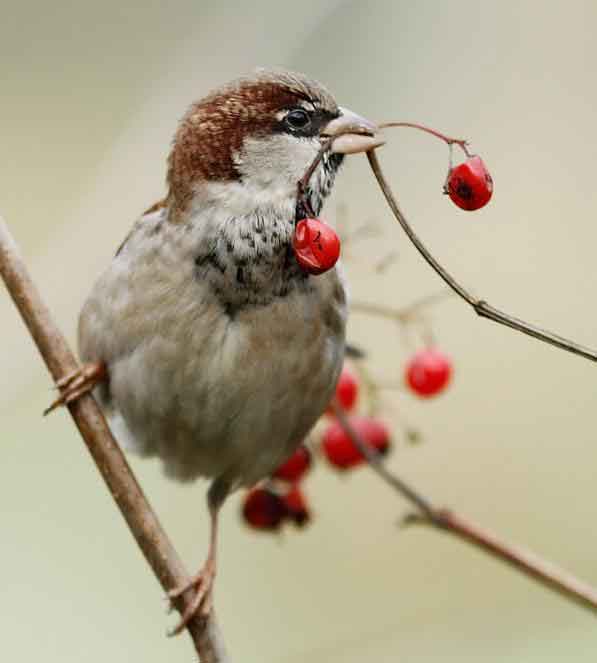
Bird-Friendly Landscaping
While all of the previously mentioned bird foods can be bought, it’s also important to mention that most them can be grown.
In fact, establishing a bird-friendly yard by planting trees and flowers that yield some of these foods is not only a sustainable way to keep birds coming back for more but it’s also great for the environment.
We won’t go into too much detail here because it depends on your region, but instead of buying black oil sunflower seeds, you could plant sunflowers and instead of putting out pieces of peaches, you could plant fruit trees.
What NOT to Give Birds
We’ve gone through all the different foods that attract birds, but now it’s time to look at foods you should never give birds. These are some of the worst foods to give birds that you might not know, but you should also use your own judgement. (For example, alcohol is an obvious thing you shouldn’t give to birds.)
Chocolate
Who doesn’t love chocolate? It’s delicious. But just because it’s delicious doesn’t mean it’s good for birds. In fact, chocolate can be lethal to birds because it’s known to cause vomiting and seizures.
Salt
A tiny amount of salt isn’t going to affect a bird, but even a moderate amount can be dangerous. Since salt itself is bad, use it as a general rule of thumb to avoid giving salty foods like chips or salted nuts.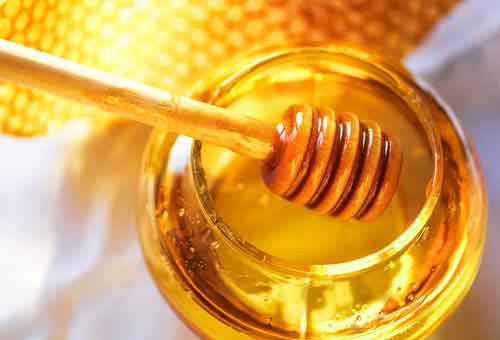
Honey
Honey is natural so birds can eat it, right? Wrong. Honey is a harbinger for mold and bacteria that can be fatal to birds, so don’t add it to your suet or nectar.
Bread
Feeding bread to birds at the park is another one of those fun pastimes that has a damaging effect on birds and the ecosystem. You can read more about why giving bread to birds is a bad idea.

